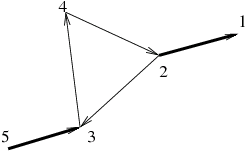
Zadanie Rak (rak)
Pomóż nam usprawnić bazę zadań!
Crayfish
Memory limit: 32 MB
In Byteland there is a pond occupied by  turtles.
In this pond there are also
turtles.
In this pond there are also  houses, numbered from
houses, numbered from  to
to  .
In each of these houses lives exactly one turtle.
Soon the crayfish migrant (who lives in Bytemerica) will come to Byteland.
This crayfish is very social and all turtles are his friends.
During his visit, the crayfish plans to stay at one of his friend's house.
But the problem is, in which house he should stay.
.
In each of these houses lives exactly one turtle.
Soon the crayfish migrant (who lives in Bytemerica) will come to Byteland.
This crayfish is very social and all turtles are his friends.
During his visit, the crayfish plans to stay at one of his friend's house.
But the problem is, in which house he should stay.
Crayfish migrant is interested in houses which will allow him to visit as many friends as possible. One could think, that visiting friends is not a problem, but in a Byteland pond it is harder that is seems. Firstly, in order to visit someone, one must reach his house. Secondly, one must also get back. We assume, that the crayfish migrant will not visit the turtle, in whose house he will stay.
Crayfish moves according to the following rules:
- Between houses the crayfish may only move using particular routes.
- Each route is one-way, and connects two distinct houses. There could be more than one route connecting the same houses.
- Crayfish can move normally or backwards.
Being in house
 and moving normally,
the crayfish can move to house
and moving normally,
the crayfish can move to house  , if there exist a route from house
, if there exist a route from house  to house
to house  . If the crayfish is moving backwards, then he can
go from house
. If the crayfish is moving backwards, then he can
go from house  to
to  if there exist a route from
if there exist a route from  to
to  .
.
- Some of the routes are special. Just after using such route the crayfish changes his moving style - if he was moving normally, then he starts moving backwards and if he was moving backwards he starts moving normally. The crayfish cannot change its moving style anywhere else.
- At the beginning of his migrations, the crayfish migrant moves backwards. When visiting a friend, the crayfish does not change moving style. At the end of his migration, the crayfish must move backwards (if the last route was special, just before entering this route the crayfish should move normally).
Task
Write a program which:
- reads the description of routes in a Byteland pond,
- for each house computes the number of friends the crayfish could visit, if he stayed at that house,
- writes the answer to the standard output.
Input
The first line of the standard input contains two integers
 and
and  (
( ,
,  ).
These numbers denote respectively: the number of houses and the number
of routes.
In the following
).
These numbers denote respectively: the number of houses and the number
of routes.
In the following  lines there are descriptions of particular routes,
each on a separate line.
Each description consists of three integers
lines there are descriptions of particular routes,
each on a separate line.
Each description consists of three integers  ,
,  and
and  (
( ,
,  ).
Integer
).
Integer  denotes the starting house number,
denotes the starting house number,  denotes
ending house number. Route is special if and only if
denotes
ending house number. Route is special if and only if  .
.
Output
Exactly  lines are to be written to the standard output.
In the
lines are to be written to the standard output.
In the  -th line exactly one integer is to be written, this
integer is the number of friends the crayfish could visit,
if he stayed at house number
-th line exactly one integer is to be written, this
integer is the number of friends the crayfish could visit,
if he stayed at house number  .
.
Example
For the input data:
5 5 2 1 1 2 3 0 3 4 0 4 2 0 5 3 1

the correct result is:
3 3 3 3 0
Staying at house number 1 the crayfish can visit friends from houses 2, 3, 4. Staying at house number 2 the crayfish can visit friends from houses 3, 4, 5. Staying at house number 3 the crayfish can visit friends from houses 2, 4, 5. Staying at house number 4 the crayfish can visit friends from houses 2, 3, 5. Staying at house number 5 the crayfish can visit none of his friends.
Task author: Szymon Acedanski.
Kontakt
In the event of technical difficulties with Szkopuł, please contact us via email at [email protected].
If you would like to talk about tasks, solutions or technical problems, please visit our Discord servers. They are moderated by the community, but members of the support team are also active there.

 English
English